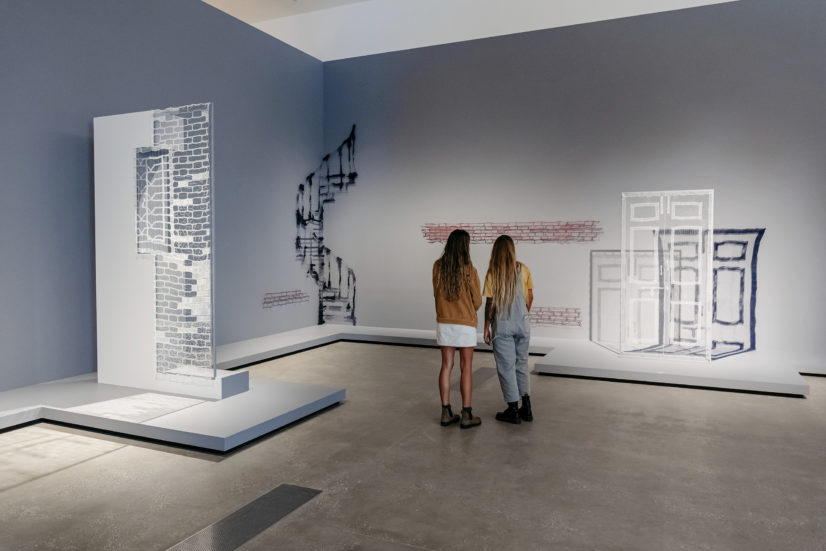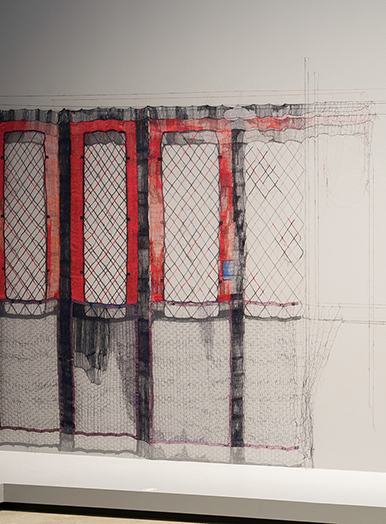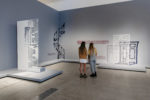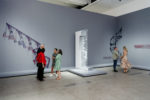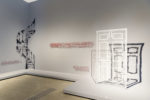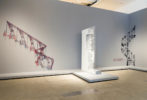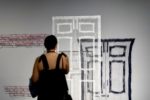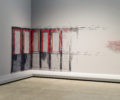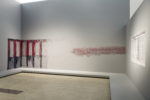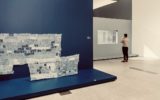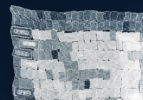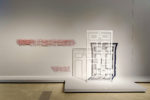Afterlife
Asia Pacific Triennial, Queensland Art Gallery & Gallery of Modern Art (QAGOMA), Australia
Afterlife: Installation view
Thread and steel frames
Room dimensions: 43 ft X 37ft
Afterlife: Installation view
Thread and steel frames
Room dimensions: 43 ft X 37ft
Afterlife: Installation view
Thread and steel frames
Spiral staircase: 144″ X 66″
Door with embroidered shadow: 83” X 42”
Brick fragments: varying sizes between 130″ to 55″
Afterlife: Fragmented Wall and Folded Staircase
Thread and steel frames
Fragmented wall: 112″ X 54″
Folded staircase: 120″ X 168″
Afterlife: Fragmented Wall and Folded Staircase
Thread and steel frames
Fragmented wall: 112″ X 54″
Folded staircase: 120″ X 168″
Afterlife: Fragmented Wall and Folded Staircase
Thread and steel frames
Fragmented wall: 112″ X 54″
Folded staircase: 120″ X 168″
Afterlife: Door with embroidered shadow
Thread and steel frame
white door: 83” X 42”
indigo shadow: 108″ X 42″
Afterlife: Detail from Door with embroidered shadow
Afterlife: Door with embroidered shadow
Thread and steel frame
white door: 83” X 42”
indigo shadow: 108″ X 42″
Afterlife: Installation view
Thread and steel frames
Room dimensions: 43 ft X 37ft
Afterlife: Fraying Veda doors
Thread
108″ X 164″
Afterlife: Detail from Fraying Veda doors
Thread
108″ X 164″
Afterlife: Detail from Fraying Veda doors
Thread
108″ X 164″
Afterlife: Installation view
Thread and steel frames
Room dimensions: 43 ft X 37ft
Afterlife: Installation view of entrance
Thread and steel frames
Room dimensions: 43 ft X 37ft
Afterlife: drawing room window
Thread structure fitted into a cut wall.
Window size: 44″ X 77″
Afterlife: brick stacks
Thread, fabric and wire
168″ X 60″
Afterlife: Detail from brick stacks
Thread, fabric and wire
168″ X 60″
Afterlife: installation view
Thread and steel frame
Life-size thread drawings of architectural fragments from the artist’s family home (33 Link Road).
Text by curator: Tarun Nagesh
Throughout her career, Sumakshi Singh has developed a spontaneous and responsive approach to both materials and space. Her rigorous explorations of spatial interventions play in the gap between conditioned knowledge and direct perception, often reversing roles or stretching open the space between background and foreground, micro and macro, between physical object and illusory experience. Her practice engages narratives from inner landscapes – of personal memory, metaphysical and emotive experience- as well as the history and physicality of the site.
Singh’s ambitious sculptural and installation practice is rooted in the intimate processes of drawing, painting, collaging, carving and embroidery. In the artist’s recent/ ongoing body of work, this has focused on ‘groundless thread drawings’. These involve a laborious, studio construction and deconstruction process that bears resonance to her earlier practices dedicated to materially intensive, site-specific interventions.
Singh started developing the threading technique around 2015 after stumbling across some of her late mother’s letters. She felt a sudden desire to trace the words in embroidery – a practice, her mother had tried to teach her as a child – using it as a way to really tie the words down to the page. Ironically, once she finished the embroidered letter, the words seemed to protest this fixity, this tying down. She began to remove the fabric that they were on, allowing them to float in space like a fragile embroidery on air. Soon a skeletal archive of flowers and plants emerged, echoing the pressed flowers from the many gardens her mother had passionately created in the various homes the family lived in, as they moved around the country. After a year of experimentation with techniques, the full possibility of this medium began to come to surface, resulting in immersive installations of ethereal, life-size gardens of embroidered plant forms and architectural facades suspended in space.
Family memories of the artist’s grandparents’ home in Delhi led to the further development of Singh’s thread-based sculptures and drawings. Her grandparents had arrived in Delhi, as refugees after the Partition of India and gradually built the family home. As a child Singh continually moved across the country, and so the old house in Delhi became her only sense of a constant home, with its familiar surfaces, objects, stories and smells. After its long history of hosting and serving the family, the home now lies abandoned.
The architectural features of the house have now become the focus of gossamer studies in thread and shadow, evolving into a series entitled ‘33 Link Road’, taking its name for the address of the old family home. Beginning with a series of the different gates at the entry to the house and developing into threaded windows, doors, staircases and architectural facades, the series captures the house frozen in time like a flower pressed between the pages of a book. Lightly strung across walls or stretched like veils in space, the insubstantial architectural forms wrap around corners and fold in on themselves, delicate and malleable like the spectral collection of memories they represent. Exposed, hanging threads and unravelled stitching translate the house into vulnerable images/fragments of home, caught in the process of being undone.
As the body of works has developed, labyrinthine installations of various objects and threaded fragments, deliberately construct interplays of spatial planes and illusory perspectives. These transparent images built into voids, levitate across floors and walls in subtle layering or find articulation through their shadows as they hover above the wall surface.
In the layered thread-drawings of brick piles, Singh also extends this idea of memory to the changing face of her neighbourhood, where old family homes are constantly being torn down, turned temporarily into construction sites and replaced with condos.
As archives of memory, the thread drawings come together to reveal ghost-like spaces where rigid architectures translate into soft veils of memory. While the forms become skeletal, fragile and adaptable, they evoke the evasive desire of the artist to tie down these fading memories, to stitch them permanently in fabric of time.
Threadwork
2023:
Exhibit 320, Delhi, India
CSMVS museum, Mumbai, India
KNMA (Kiran Nadar Museum of Art), Noida, India
2022:
Asia Pacific Triennial QAGOMA
2021:
Aicon Contemporary, New York & 1X1 Art Gallery, Dubai
2020:
Kiran Nadar Museum of Art, Delhi
2019:
Sakshi Gallery, Mumbai, India
Hermès, The Chanakya, New Delhi
2019-current:
Architectural Thread Drawings
2018:
Wilfrid Israel Museum, Israel
Belgrade Biennale/ 58th October Salon, Serbia
2017:
Dr. Bhau Daji Lad Mumbai City Museum
India Art Fair/ FOCUS
C24 Gallery, New York, USA
2016:
Exhibit 320, New Delhi, India
Saatchi Gallery, London, UK & Art Houz, Chennai, India
2015:
SPACE, Wood Street Galleries, Pittsburgh, USA
2015-current:
Botanical Thread Drawings & Vitrines

